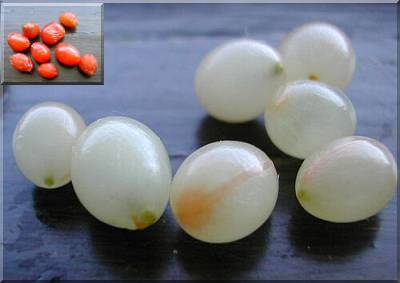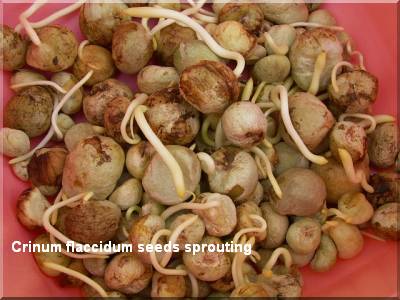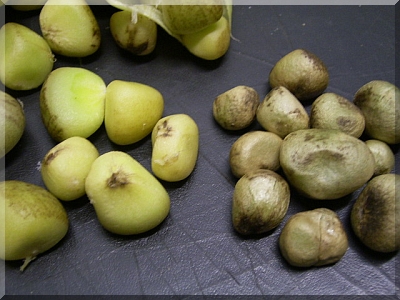|
Above, Haemanthus albiflos seeds with the outer fruit removed. The insert shows the seeds still in their fruity skins.
Notes:
There is a group of Amaryllids that produce fleshy seeds as a
form of reproduction. This group can also be narrowed further by
continent. South African Amaryllidaceous geophytes in this fleshy seeds
group contain the genus Amaryllis (2 known Taxa. none weedy), Crinum
(150+ known Taxa. world wide, Approx 50+ Taxa. in Republic
of South Africa, none weedy), Haemanthus Approx 21 Taxa. None weedy many
endangered) Ammocharis Approx. 2 Taxa. None weedy, Boophone (3 species,
none weedy,) Crossyne ((recently re-named from Boophone) 2 species, none
weedy). There are more, smaller genus geophytes too. Some of these
include, Strummaria, Gethyllis, Hessea, these are none weedy also and
some are endangered. In the genus Crinum, some 150+ species and 1000ís of hybrids, all are none weedy and present no threat to Australian Horticulture, as these are ornamental plants. The seeds of Crinum are sometimes smooth, or rough, can be the size of a pea, up to the size of a mans fist. Some seeds have a round, furry covering (those from arid regions) and some will germinate in transit. Although the seed have shot and produced a small bulb, this biomaterial is still considered as seed material and is not a bulb. Consider that the soil has not been in contact with the seed/bulb and the bulb will be connected with a radical and still feeding from the seed as such. End.
Amaryllidaceae seeds basically come in many forms. Black winged seeds of the Genus Cyrtanthus. Hard, round black/brown seeds from Genus such as Galanthus and Narcissus. Thick segment/disk shaped seeds from the Genus Worsleya. And fleshy seeds. Fleshy Seeds are the seeds I have addressed on this page. These can be Round/Oblong/Rough in shape and have a short viability time due to the fast germination signals within the seed. These seeds are best planted as soon as obtained, pressed into a large pot of a mostly sandy medium. A good recipe I have used is 1 Part Potting Mix to 6 Parts of washed river sand. Raising the smaller Amaryllids such as Strumaria, Hessea and Gethyllis in pots to begin their life, is a sound way of ensuring success. You may cover the seeds if you are raising them out doors. When I cover the seeds out doors I use only sand. This is an easy medium for the shoot to break through I have found. As a general rule of thumb, in the greenhouse, the seeds will not need to be covered, simply pressed into the medium and left to germinate. Planting out in the garden can be in their second or third year, depending on where they go and if they are large enough to fend for themseles i.e. they won't get grown over.
Above, Crinum species (left) just picked and Crinum bulbispermum, picked one week apart. Most Crinum seeds, once picked, turn this colour. Notes: Nerine, Scadoxus, Ammocharis, Haemanthus, Gethyllis, Apodolirion, Strumaria, Hessea, Crinum, Boophone, Crossyne, Amaryllis, Brunsvigia and Clivia. All have fleshy seeds and a short viability (shelf life). All can be considered as possible germinators in transit. When you order these seeds from a collector or supplier, be sure to let them know that you want to get the seeds as soon as possible. There is every possibility that your seeds may be help up at AQIS when they enter the country. Please direct them to this page. Here is the link to this page to copy and paste to send to the Officer in charge of a seizure Amaryllidaceae Seeds Should you encounter further difficulties, please let me know and I will see if there is anything I can do to help. Happy Germinations,
Dash.
Above, Crinum seeds showing the radicle as they emerge. Up until now, the entire food source is from the seed. Once in contact with soil, the radicle with develop basal/root and bulb material.
|
||



